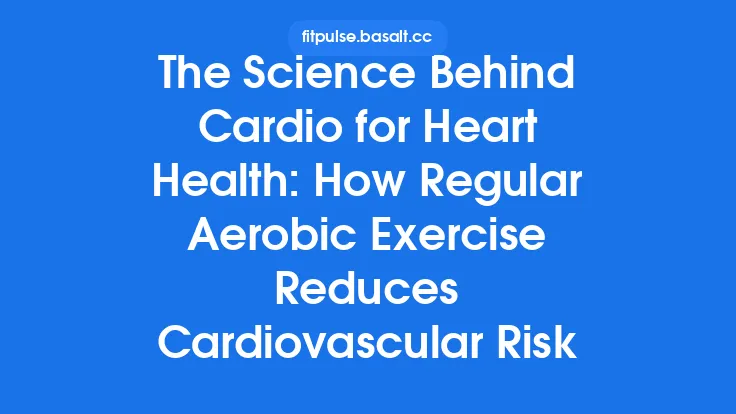Regular physical activity is one of the most powerful, evidence‑based tools we have for preventing a wide range of chronic diseases. Unlike many pharmacological interventions, exercise works systemically, influencing metabolism, hormone balance, tissue architecture, and cellular signaling pathways simultaneously. This guide synthesizes the most robust scientific findings into a clear, evergreen resource that can be consulted at any stage of life or career. It explains why exercise matters for chronic disease risk, how different modalities act on specific physiological systems, and what practical parameters (frequency, intensity, time, and type) consistently produce protective effects.
The Epidemiological Landscape: Exercise and Chronic Disease Incidence
Large‑scale cohort studies spanning decades have repeatedly shown an inverse relationship between habitual physical activity and the onset of chronic conditions. For example:
| Chronic Condition | Relative Risk Reduction (≥150 min/week moderate activity) |
|---|---|
| Type 2 diabetes | 30–50 % |
| Colorectal cancer | 20–30 % |
| Breast cancer (post‑menopausal) | 15–25 % |
| Osteoporosis (fracture risk) | 25–35 % |
| Chronic kidney disease progression | 15–20 % |
| Chronic obstructive pulmonary disease (COPD) exacerbations | 20–30 % |
These figures emerge after adjusting for confounders such as diet, smoking, and socioeconomic status, underscoring that the protective effect of exercise is independent and additive. Importantly, the dose‑response curve is curvilinear: even modest activity (e.g., 75 min/week of vigorous effort) confers measurable benefit, while higher volumes amplify risk reduction without a clear plateau.
Metabolic Pathways: Enhancing Glucose Homeostasis
1. Muscle Glucose Uptake and Insulin Sensitivity
Skeletal muscle accounts for ~80 % of post‑prandial glucose disposal. Acute bouts of aerobic exercise stimulate translocation of GLUT‑4 transporters to the sarcolemma via an insulin‑independent pathway mediated by AMP‑activated protein kinase (AMPK) and calcium‑calmodulin‑dependent protein kinase (CaMK). This effect persists for 24–48 hours, creating a “metabolic window” during which insulin sensitivity is markedly improved.
2. Glycogen Repletion and Substrate Switching
Repeated training induces mitochondrial biogenesis (via PGC‑1α activation) and enhances oxidative capacity. Consequently, muscles preferentially oxidize fatty acids at rest, sparing glucose for essential tissues and reducing chronic hyperglycemia—a key driver of type 2 diabetes pathogenesis.
3. Hepatic Gluconeogenesis Suppression
Endurance training down‑regulates hepatic phosphoenolpyruvate carboxykinase (PEPCK) and glucose‑6‑phosphatase, curbing excessive glucose output. This hepatic adaptation complements peripheral insulin sensitivity, collectively lowering fasting plasma glucose and HbA1c levels.
Body Composition and Fat Distribution: The Exercise‑Obesity Axis
Visceral Adiposity
Visceral fat is metabolically active, secreting pro‑inflammatory cytokines (IL‑6, TNF‑α) and adipokines (resistin) that exacerbate insulin resistance and oncogenic pathways. Resistance training and high‑intensity interval training (HIIT) preferentially mobilize intra‑abdominal triglycerides through catecholamine‑driven lipolysis, reducing waist circumference more effectively than low‑intensity steady‑state cardio.
Lean Mass Preservation
Sarcopenia—loss of muscle mass—accelerates metabolic decline. Progressive resistance exercise stimulates the mTOR pathway, promoting protein synthesis and preserving lean tissue. Higher lean mass improves basal metabolic rate, creating a virtuous cycle of energy expenditure that mitigates weight gain.
Energy Balance and Appetite Regulation
Exercise modulates appetite hormones: acute bouts increase peptide YY (PYY) and glucagon‑like peptide‑1 (GLP‑1), while chronic training attenuates ghrelin spikes. This hormonal milieu helps regulate caloric intake, supporting long‑term weight stability.
Hormonal Modulation and Cancer Risk Reduction
Estrogen Metabolism
Physical activity enhances hepatic cytochrome P450 enzymes that favor the 2‑hydroxyestrone pathway, producing less potent estrogen metabolites. Lower circulating estradiol reduces mitogenic stimulation of estrogen‑responsive tissues, decreasing breast and endometrial cancer risk.
Insulin‑Like Growth Factor (IGF‑1) Axis
Elevated IGF‑1 promotes cellular proliferation and inhibits apoptosis. Regular exercise reduces circulating IGF‑1 and increases IGF‑binding protein‑3 (IGFBP‑3), which sequesters IGF‑1, thereby dampening oncogenic signaling in colon, prostate, and lung tissues.
Inflammatory Cytokine Suppression
Chronic low‑grade inflammation is a recognized hallmark of tumorigenesis. Exercise induces an anti‑inflammatory environment by increasing interleukin‑10 (IL‑10) and decreasing C‑reactive protein (CRP). This shift curtails DNA damage and angiogenesis associated with malignant transformation.
Bone Health: Mechanical Loading and Osteoporosis Prevention
Osteogenic Stimulus
Weight‑bearing activities (e.g., walking, jogging, resistance training) generate strain on the skeletal matrix, activating osteocytes that release sclerostin‑inhibiting signals. The resultant up‑regulation of the Wnt/β‑catenin pathway stimulates osteoblast differentiation and bone formation.
Calcium Homeostasis
Exercise improves renal calcium reabsorption and stimulates the production of 1,25‑dihydroxyvitamin D, enhancing intestinal calcium absorption. Coupled with mechanical loading, this biochemical environment supports higher bone mineral density (BMD) and reduces fracture incidence.
Site‑Specific Benefits
High‑impact activities (e.g., jumping, plyometrics) preferentially benefit trabecular bone (spine, pelvis), while resistance training strengthens cortical bone (femur, forearm). A mixed program that incorporates both modalities yields the most comprehensive skeletal protection.
Inflammation and Immune Modulation: A Chronic Disease Nexus
Exercise exerts a biphasic effect on the immune system:
- Acute Anti‑Inflammatory Response – During and immediately after activity, muscle contractions release myokines (e.g., IL‑6, IL‑15) that act systemically to inhibit pro‑inflammatory cytokine production.
- Chronic Adaptation – Repeated sessions lower basal levels of CRP, TNF‑α, and IL‑1β, attenuating the persistent inflammatory milieu that drives atherosclerosis, insulin resistance, and neurodegeneration.
These immunomodulatory actions are independent of weight loss, highlighting that even lean individuals reap anti‑inflammatory benefits from regular movement.
Musculoskeletal Strength and Joint Health: Guarding Against Osteoarthritis
Cartilage Preservation
Dynamic loading stimulates chondrocyte synthesis of proteoglycans and type II collagen, maintaining extracellular matrix integrity. Moderate‑intensity resistance and low‑impact aerobic exercise (e.g., cycling, swimming) promote synovial fluid circulation, delivering nutrients to avascular cartilage.
Muscle‑Joint Synergy
Strong peri‑articular muscles absorb shock and stabilize joints, reducing mechanical stress on articular surfaces. Quadriceps and hamstring strengthening, in particular, has been shown to lower knee‑joint load during gait, slowing progression of knee osteoarthritis.
Neuromuscular Coordination
Balance and proprioceptive training improve joint position sense, decreasing the risk of acute injuries that can precipitate chronic joint degeneration.
Renal and Pulmonary Benefits of Regular Exercise
Kidney Function
Aerobic conditioning improves renal perfusion and glomerular filtration rate (GFR) by enhancing endothelial nitric oxide production and reducing systemic blood pressure. In individuals with early‑stage chronic kidney disease (CKD), regular moderate‑intensity exercise slows the decline of eGFR by 1–2 mL/min/1.73 m² per year compared with sedentary controls.
Lung Capacity and COPD Management
While not the primary focus of respiratory disease articles, it is worth noting that regular aerobic activity increases tidal volume and improves ventilatory efficiency (lower VE/VCO₂ slope). For patients with mild to moderate COPD, structured endurance training reduces dyspnea scores and the frequency of exacerbations, indirectly lowering the risk of disease progression.
Dose‑Response Relationship: The FITT Principle for Chronic Disease Prevention
| Component | Recommended Range for Chronic Disease Risk Reduction | Example Activities |
|---|---|---|
| Frequency | 3–5 days per week (minimum) | Walking, cycling, resistance circuits |
| Intensity | Moderate (40–60 % VO₂max) or vigorous (≥70 % VO₂max) | Brisk walking, jogging, HIIT |
| Time | 150 min/week moderate or 75 min/week vigorous (or equivalent combination) | 30 min ×5 days, or 25 min ×3 days |
| Type | Mix of aerobic, resistance, and flexibility | 2 days cardio + 2 days strength + 1 day yoga/stretching |
Progression Guidelines
- Initial Phase (Weeks 1‑4): Emphasize consistency; aim for 10‑20 min sessions at low‑moderate intensity.
- Adaptation Phase (Weeks 5‑12): Increase duration by 5‑10 min per session and introduce moderate resistance (2‑3 sets of 8‑12 reps).
- Optimization Phase (Month 4+): Incorporate interval training (e.g., 1 min high intensity/2 min recovery) and periodize resistance loads (progressive overload).
Safety Note – While the article avoids a full “guidelines for safe exercise” discussion, it is prudent to advise individuals with known chronic conditions to obtain medical clearance before initiating high‑intensity programs.
Practical Recommendations for Sustainable Exercise Regimens
- Start with What You Enjoy – Preference predicts adherence. Choose activities that align with personal interests and lifestyle constraints.
- Use the “10‑Minute Rule” – If time feels limited, commit to a 10‑minute bout; three such bouts can be combined to meet weekly targets.
- Integrate Strength Early – Even novice lifters benefit from body‑weight exercises (squats, push‑ups) before progressing to external loads.
- Track Objective Metrics – Heart rate monitors, step counters, or simple logbooks provide feedback and reinforce progress.
- Periodically Reassess – Every 8‑12 weeks, evaluate fitness markers (e.g., VO₂max estimate, 1‑RM strength) and adjust volume/intensity accordingly.
- Balance Recovery – Include at least one full rest day per week and incorporate low‑intensity active recovery (e.g., gentle walking, stretching) to mitigate overuse injuries.
Monitoring Progress and Adjusting Programs
| Parameter | Assessment Tool | Frequency | Interpretation |
|---|---|---|---|
| Cardiorespiratory Fitness | Submaximal treadmill test or 6‑minute walk test | Every 3 months | ↑ VO₂max >5 % indicates meaningful adaptation |
| Muscular Strength | 1‑RM or 5‑RM on major lifts (bench press, squat) | Every 3 months | ↑ 10 % strength suggests effective overload |
| Body Composition | DXA scan or bioelectrical impedance | Annually | ↓ visceral fat % >5 % correlates with reduced metabolic risk |
| Bone Density | DXA (lumbar spine, hip) | Every 2 years (if at risk) | ↑ BMD ≥1 % signals osteogenic benefit |
| Blood Biomarkers | Fasting glucose, HbA1c, lipid panel, CRP | Annually | Improvements reflect systemic health gains |
When plateaus arise, consider modality rotation (swap jogging for cycling), intensity spikes (add HIIT intervals), or volume adjustments (increase sets/reps). Such strategic variations re‑stimulate physiological pathways and sustain long‑term risk reduction.
Concluding Perspective
Exercise is a multifaceted, self‑reinforcing intervention that simultaneously targets the metabolic, hormonal, inflammatory, and structural determinants of chronic disease. Its protective capacity is not confined to a single organ system; rather, it orchestrates a systemic environment that discourages the development and progression of conditions ranging from type 2 diabetes and certain cancers to osteoporosis and chronic kidney disease. By adhering to the evidence‑based FITT framework, progressively challenging the body, and monitoring key health markers, individuals can harness the enduring power of movement to safeguard their health across the lifespan.





